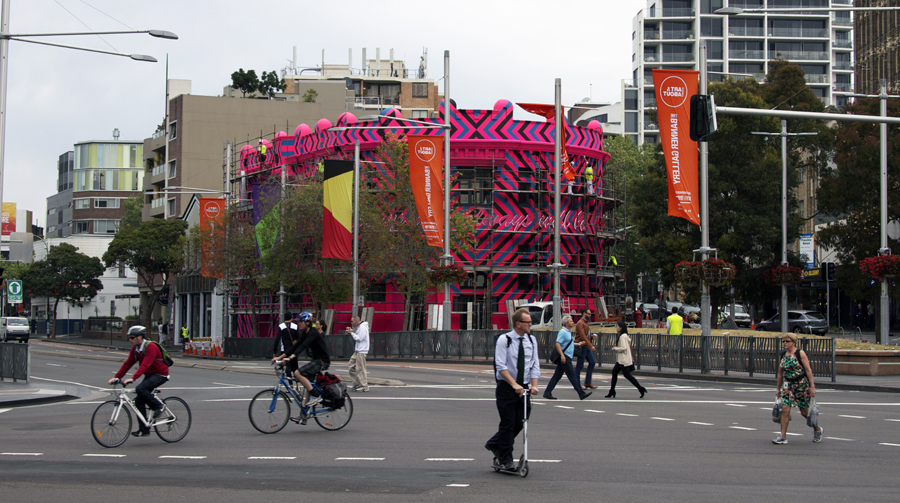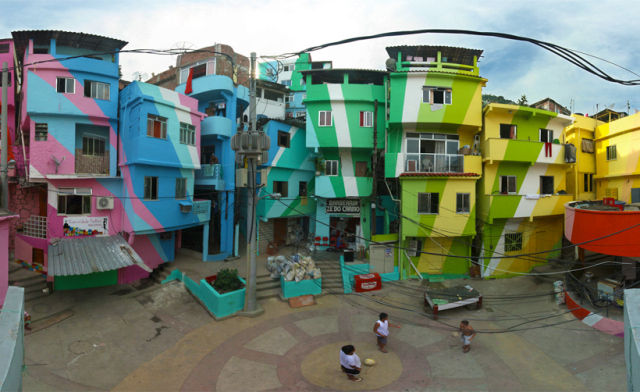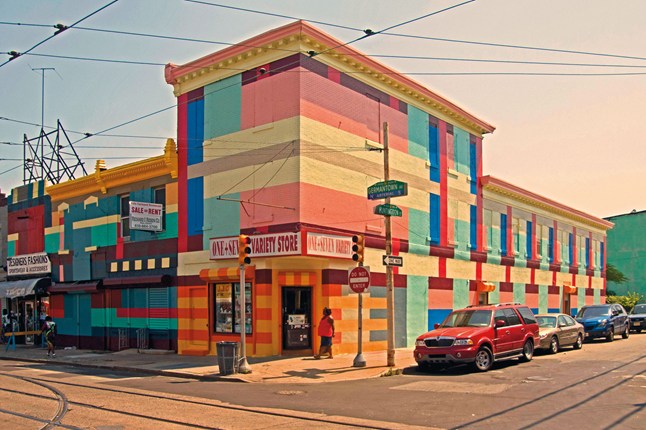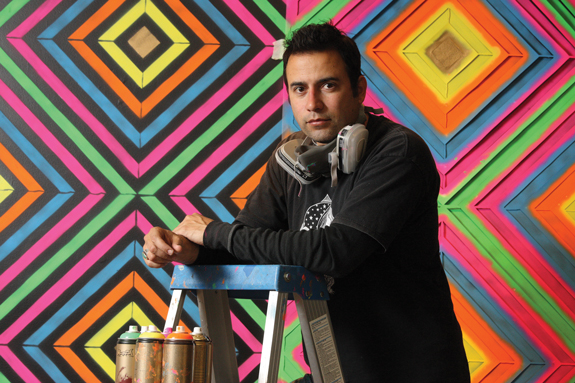When a Building Brightens a Neighbourhood
Reko Rennie's Welcome to Redfern is part of a history of large-scale murals that have driven urban renewal.
Redfern is getting itself a facelift. Commissioned by the City of Sydney, renowned street artist Reko Rennie and a team of young Aboriginal artists have designed and painted a mural covering an entire Redfern terrace as a tribute and monument to the neighbourhood's rich history of Aboriginal activism and urban culture. Entitled Welcome to Redfern the mural was launched today and marks the first step in the City of Sydney Council's ambitious Eora Journey project to give Indigenous culture and issues more public recognition.
The local artists — Nahdia Noter, Trae Campbell, Ji Duncan-Weatherby, Tyrrelle McGrath, Brandon Phillips, Isaac Phillips, Josh Addo and Josh Nolan — helped to paint the mural's bold stripes in red, yellow and black and added paste-ups of 'local heroes', including colonial leader Pemulwuy and activists Charles Perkins and Mum Shirl. "These young artists have grown up in and around The Block, and the imagery is a colourful reminder of these incredible leaders to make sure the next generation will remember them, too," said Rennie, a Kamilaroi man and Archibald finalist who's also responsible for the bright pink T2 Building at Taylor Square.
But why are art murals like this significant? While these sort of public projects undoubtedly do much to brighten the aesthetics of rundown urban landscapes, there is a legitimate concern that they offer little more than a highly visible and PR-friendly band-aid solution to the deep and divisive problems that have plagued the local Indigenous communities. The disparity between Indigenous and non-Indigenous Australians in terms of life expectancy, education and unemployment levels remain glaringly pronounced and so the question remains: what does a mural have to offer as a tactic for urban renewal?
One of the biggest advocates for street art as a means of urban renewal has been the Dutch duo of Jeroen Koolhaas & Dre Urhahn, who more commonly go by the name of Haas and Hahn. These pioneering muralists — with the help of local artists and enthusiasts — have converted some of the world's poorest urban landscapes into living, breathing works of art. Their project in the slums of Rio de Janeiro converted the once derelict and incredibly dangerous area into a sprawling, breathtaking mural described by the New York Times as a "radiant, updated form of real-life Cubism".
The remarkable effect that these murals have on the local community can be more clearly seen in Haas and Hahn's 18-month endeavour to spice up Philadelphia's Germantown. Not only did this project employ dozens of locals but it has also stimulated economic growth and development in the area and given the poverty-stricken region a new lease of life.
Mohammed, one of the painters and leaders of the 'Philly Project' told documentary maker Jon Kauffman that the murals had an amazing capacity to lift the hopes and spirits of the artists and the local community. "Everybody's had hard times," he said, "but since I've been working here it's kinda like getting me away from my little troubles." It is these sentiments that give credence to Haas & Hahn's street art philosophy: "what feeds the heart feeds the soul".
Closer to home, large-scale murals Melbourne's inner northern suburbs have become a hub for cultural, artistic and political expression thanks to a long series of Indigenous murals dating back to the early 1980s. The murals of the Collingwood Housing Estate often depict traditional Aboriginal iconography such as of the Australian landscape pre-settlement/invasion and Indigenous elders in warpaint and traditional dress, but it is the process of their creation that is perhaps of greater interest. These murals were born out of collaboration between a collection of local muralists known as the BEEM artists and a number of homeless Aboriginal people who live in the nearby park and identify themselves as 'parkies'.
The contrasting styles of the artists and the resulting murals — with the street graffiti style of the 'parkies' often in conflict with the more refined portraits of the BEEM artists — is demonstrative of this unique collaboration. According to Denise Lovett, one of the leaders of the project, these murals have provided the local Indigenous community with a sense of cultural ownership over the urban landscape and banded the community together across lines of socio-economic status and ethnicity.
So will the City of Sydney's newest mural provide this sort of urban renewal to the Redfern area? For his part, Rennie led the young Redfern artists through workshops covering artistic techniques, as well as other valuable skills. "We talked about how art can benefit an individual, and how success as an artist can be measured, such as by the ability to travel and work in other communities," he said.
And Welcome to Redfern is only the very tip of the iceberg. The sweeping reforms of the Eora Journey include not only a further six Indigenous art projects to be scattered across the city but a number of other cultural and economic projects, including a permanent Indigenous Cultural Centre. One thing we can be certain of: the 'Welcome to Redfern' mural has far more to offer the urban landscape than simply pretty colours.
Top image of Reko Rennie, Sydney Lord Mayor Clover Moore and curator Hetti Perkins.










